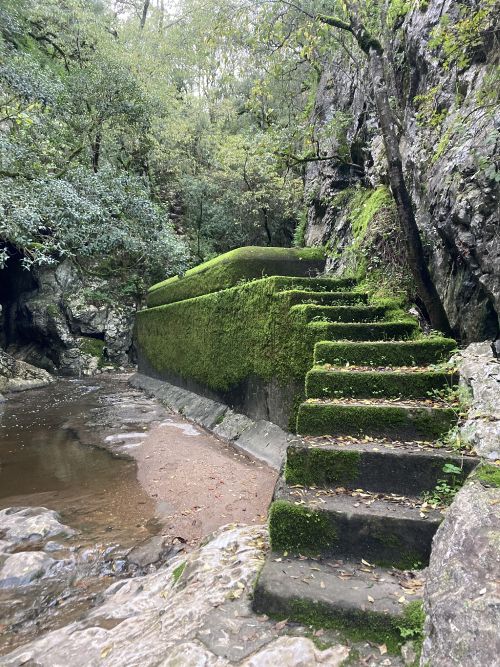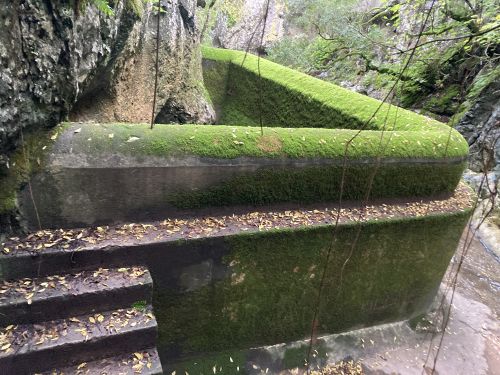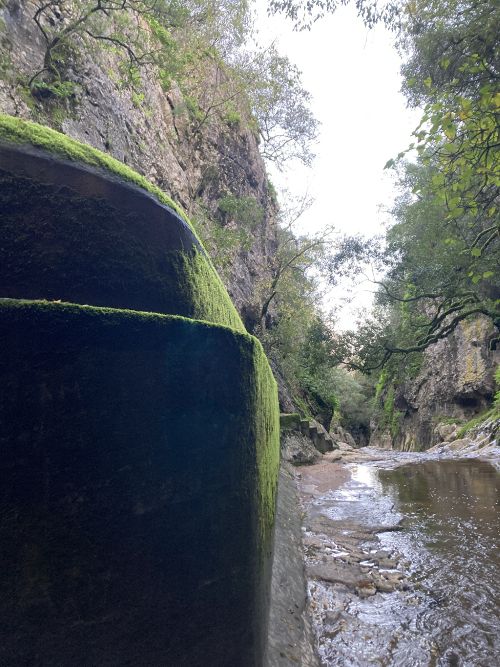No edit summary |
No edit summary |
||
| Line 12: | Line 12: | ||
== '''Describe, by listing… (meaningless)''' == | |||
The Participatory Performance Describe, by listing… (meaningless) is an attempt to create a modern ceremony - balancing a scientific approach with a spiritual practice. By following the guiding words of the performer, the participants are describing the space, in which the performance is taking place. Through these voiced descriptions, the participants are investigating layers of relationships between them and the space. These investigations loosen the boarder between their outside and inside realm. By doing so, a sensation of a one-ness, between them and the space, is trying to be created. | |||
The space, that the participants are investigating, is a space that is existing in a vacuum of meaninglessness. It is a space formerly dominated by human presence and the accompanying projections of meaning and function - that has been abandoned and is now in the process of redefining itself. This transforming state, is a process without ending. It is a symbiosis between birth and death, between decay and becoming alive, between construction and destruction. This space, expressing a transforming movement, is defined by the actors in it. It is these actors, which constitute the space and that cannot be separated from it. By taking the action of stepping into the space, the participants become part of it. They become another actor in the space. They become the space. Making this process experienceable is the goal of the performance. | |||
Developing a practice to connect to the actors of a space and thereby dissolving the illusion of individuality - holds potential to rethink the current societal approach on relating the the environment. | |||
Through the performative fusing of participator and the space, questions of meaning making, demarcation, subject/object relationships and non-human agency are being opened. | |||
'''(Procedure of the Ceremony)''' | |||
When arriving the participant shall be welcomed warmly. | |||
During the welcoming a microphone shall be attached to each participant. | |||
The participants shall be invited to loosely spread around a space. | |||
The performer shall walk among them, dressed in ceremonial clothes. | |||
The ceremonial words shall be read out loud. There shall be a considerable pause between every instruction. | |||
Every line of score shall be preceded by a gentle gong, that the performer shall sound to catch the participants attention. | |||
The participants shall be invited to describe the space, led by the performers instructions. | |||
The descriptions by the participators shall be spoken out loudly and recorded with the microphones. | |||
The participants shall not talk to each other, but only to them selves and the space. | |||
The script shall be followed from beging to end. There shall be no improvisation in the ceremonial score. | |||
The performance shall be finished by the act of collecting the microphones and recorded voices. | |||
During the act of removing the microphones, the performer shall express their gratitude for the participation. | |||
This collected of contemplations shall be brought together in an audio-composition, after the participators have left. | |||
'''(Ceremonial Words)''' | |||
''Describe the space, by listing what you see.'' | |||
''Describe the space, by listing the functions of what you see.'' | |||
''Describe the space, by listing the interactions between the functions of see.'' | |||
'' | ''Describe yourself, by listing everything you perceive.'' | ||
''Describe yourself, by listing the interactions between what you perceive.'' | |||
''Describe yourself, by listing the meaning behind the interactions between what you perceive.'' | |||
''Describe the space, by listing the interactions between you and the space.'' | |||
''Describe the space, by listing the functions of the interactions between you and the space.'' | |||
''Describe the space, by listing the meaning behind the functions of the interconnections between you and the space.'' | |||
''Describe, by listing: Function of the space.'' | |||
''Describe, by listing: Boarders of the space.'' | |||
''Describe, by listing: Myself and the space.'' | |||
[[File:describe_diagram of influences.jpg|1500px]] | |||
Revision as of 19:15, 16 January 2023
Resonanzen of the abandoned
Project sketch
''concept state of 01.12.2022''
''concept state of 08.01.2023''
Describe, by listing… (meaningless)
The Participatory Performance Describe, by listing… (meaningless) is an attempt to create a modern ceremony - balancing a scientific approach with a spiritual practice. By following the guiding words of the performer, the participants are describing the space, in which the performance is taking place. Through these voiced descriptions, the participants are investigating layers of relationships between them and the space. These investigations loosen the boarder between their outside and inside realm. By doing so, a sensation of a one-ness, between them and the space, is trying to be created.
The space, that the participants are investigating, is a space that is existing in a vacuum of meaninglessness. It is a space formerly dominated by human presence and the accompanying projections of meaning and function - that has been abandoned and is now in the process of redefining itself. This transforming state, is a process without ending. It is a symbiosis between birth and death, between decay and becoming alive, between construction and destruction. This space, expressing a transforming movement, is defined by the actors in it. It is these actors, which constitute the space and that cannot be separated from it. By taking the action of stepping into the space, the participants become part of it. They become another actor in the space. They become the space. Making this process experienceable is the goal of the performance. Developing a practice to connect to the actors of a space and thereby dissolving the illusion of individuality - holds potential to rethink the current societal approach on relating the the environment.
Through the performative fusing of participator and the space, questions of meaning making, demarcation, subject/object relationships and non-human agency are being opened.
(Procedure of the Ceremony)
When arriving the participant shall be welcomed warmly. During the welcoming a microphone shall be attached to each participant. The participants shall be invited to loosely spread around a space. The performer shall walk among them, dressed in ceremonial clothes. The ceremonial words shall be read out loud. There shall be a considerable pause between every instruction. Every line of score shall be preceded by a gentle gong, that the performer shall sound to catch the participants attention. The participants shall be invited to describe the space, led by the performers instructions. The descriptions by the participators shall be spoken out loudly and recorded with the microphones. The participants shall not talk to each other, but only to them selves and the space. The script shall be followed from beging to end. There shall be no improvisation in the ceremonial score. The performance shall be finished by the act of collecting the microphones and recorded voices. During the act of removing the microphones, the performer shall express their gratitude for the participation. This collected of contemplations shall be brought together in an audio-composition, after the participators have left.
(Ceremonial Words)
Describe the space, by listing what you see.
Describe the space, by listing the functions of what you see.
Describe the space, by listing the interactions between the functions of see.
Describe yourself, by listing everything you perceive.
Describe yourself, by listing the interactions between what you perceive.
Describe yourself, by listing the meaning behind the interactions between what you perceive.
Describe the space, by listing the interactions between you and the space.
Describe the space, by listing the functions of the interactions between you and the space.
Describe the space, by listing the meaning behind the functions of the interconnections between you and the space.
Describe, by listing: Function of the space.
Describe, by listing: Boarders of the space.
Describe, by listing: Myself and the space.
Example picture of a transmorphic space found in Portugal in the environment of the Quarry Sonnet program.
old idea (contiued in Migas class)
not all who die are gone
Detailed process documentation on:



